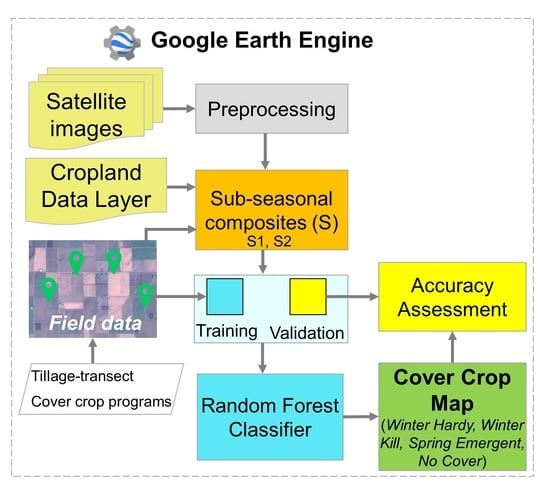Assessment of the Spatial and Temporal Patterns of Cover Crops Using Remote Sensing
Abstract
:1. Introduction
2. Materials and Methods
2.1. Data
2.1.1. Satellite Data Acquisition and Preprocessing
2.1.2. Harmonic Analyses and Seasonal Composites
2.1.3. Filling in Data Gaps in Seasonal Composites
2.1.4. Field Data
2.2. Cover Crop Classification
2.3. Weather Variability and Cover Crop Areas
3. Results
3.1. Accuracy Assessment
3.2. Cover Crop Areas: Temporal Patterns
3.3. Effects of Weather on Variation in Winter Cover
4. Discussions
4.1. Training Dataset
4.2. Pixel Based Classification and Preparation of Training Dataset
4.3. Variation in Winter Cover and Effects of Weather
4.4. Weed versus Cover Crops
5. Conclusions
Author Contributions
Funding
Acknowledgments
Conflicts of Interest
References
- Dabney, S.M.; Delgado, J.A.; Reeves, D.W. Using winter cover crops to improve soil and water quality. Commun. Soil Sci. Plant Anal. 2001, 32, 1221–1250. [Google Scholar] [CrossRef]
- Sharpley, A.N.; Daniel, T.; Gibson, G.; Bundy, L.; Cabrera, M.; Sims, T.; Stevens, R.; Lemunyon, J.; Kleinman, P.; Parry, R. Best Management Practices to Minimize Agricultural Phosphorus Impacts on Water Quality; ARS-163; USDA-ARS: Washington, DC, USA, 2006.
- Villamil, M.B.; Bollero, G.A.; Darmody, R.G.; Simmons, F.W.; Bullock, D.G. No-Till Corn/Soybean Systems Including Winter Cover Crops. Soil Sci. Soc. Am. J. 2006, 70, 1936–1944. [Google Scholar] [CrossRef]
- Strock, J.S.; Porter, P.M.; Russelle, M.P. Cover Cropping to Reduce Nitrate Loss through Subsurface Drainage in the Northern U.S. Corn Belt. J. Environ. Qual. 2004, 33, 1010–1016. [Google Scholar] [CrossRef]
- Muenich, R.L.; Kalcic, M.; Scavia, D. Evaluating the Impact of Legacy P and Agricultural Conservation Practices on Nutrient Loads from the Maumee River Watershed. Environ. Sci. Technol. 2016, 50, 8146–8154. [Google Scholar] [CrossRef] [PubMed]
- Parr, M.; Grossman, J.M.; Reberg-Horton, S.C.; Brinton, C.; Crozier, C. Nitrogen Delivery from Legume Cover Crops in No-Till Organic Corn Production. Agron. J. 2011, 103, 1578–1590. [Google Scholar] [CrossRef]
- Behnke, G.D.; Villamil, M.B. Cover crop rotations affect greenhouse gas emissions and crop production in Illinois, USA. Field Crop. Res. 2019, 241, 107580. [Google Scholar] [CrossRef]
- Brennan, E.B.; Smith, R.F. Winter Cover Crop Growth and Weed Suppression on the Central Coast of California. Weed Technol. 2005, 19, 1017–1024. [Google Scholar] [CrossRef]
- Wilcoxen, C.A.; Walk, J.W.; Ward, M.P. Use of cover crop fields by migratory and resident birds. Agric. Ecosyst. Environ. 2018, 252, 42–50. [Google Scholar] [CrossRef]
- Rundquist, S.; Carlson, S. Mapping Cover Crops on Corn and Soybeans in Illinois, Indiana and Iowa, 2015–2016; Environmental Working Group: Washington, DC, USA, 2017. [Google Scholar]
- Roesch-Mcnally, G.E.; Basche, A.D.; Arbuckle, J.G.; Tyndall, J.C.; Miguez, F.E.; Bowman, T.; Clay, R. The trouble with cover crops: Farmers’ experiences with overcoming barriers to adoption. Renew. Agric. Food Syst. 2018, 33, 322–333. [Google Scholar] [CrossRef] [Green Version]
- CTIC. Annual Report 2019–2020 National Cover Crop Survey; CTIC: West Lafayette, IN, USA, 2020. [Google Scholar]
- Hagen, S.C.; Delgado, G.; Ingraham, P.; Cooke, I.; Emery, R.; Fisk, J.P.; Melendy, L.; Olson, T.; Patti, S.; Rubin, N.; et al. Mapping conservation management practices and outcomes in the corn belt using the operational tillage information system (Optis) and the denitrification–decomposition (DNDC) model. Land 2020, 9, 408. [Google Scholar] [CrossRef]
- Tao, Y.; You, F. Prediction of Cover Crop Adoption through Machine Learning Models using Satellite-derived Data. IFAC Pap. 2019, 52, 137–142. [Google Scholar] [CrossRef]
- Seifert, C.A.; Azzari, G.; Lobell, D.B. Satellite detection of cover crops and their effects on crop yield in the Midwestern United States. Environ. Res. Lett. 2018, 14. [Google Scholar] [CrossRef]
- Thieme, A.; Yadav, S.; Oddo, P.C.; Fitz, J.M.; McCartney, S.; King, L.A.; Keppler, J.; McCarty, G.W.; Hively, W.D. Using NASA Earth observations and Google Earth Engine to map winter cover crop conservation performance in the Chesapeake Bay watershed. Remote Sens. Environ. 2020, 248, 111943. [Google Scholar] [CrossRef]
- Hively, W.D.; Duiker, S.; McCarty, G.; Prabhakara, K. Remote sensing to monitor cover crop adoption in southeastern Pennsylvania. J. Soil Water Conserv. 2015, 70, 340–352. [Google Scholar] [CrossRef] [Green Version]
- USGS. Landsat 8 Collection 1 (C1) Land Surface Reflectance Code (LaSRC) Product Guide; USGS: Sioux Falls, SD, USA, 2020; Volume 1.
- Gorelick, N.; Hancher, M.; Dixon, M.; Ilyushchenko, S.; Thau, D.; Moore, R. Google Earth Engine: Planetary-scale geospatial analysis for everyone. Remote Sens. Environ. 2017, 202, 18–27. [Google Scholar] [CrossRef]
- Xiong, J.; Thenkabail, P.S.; Gumma, M.K.; Teluguntla, P.; Poehnelt, J.; Congalton, R.G.; Yadav, K.; Thau, D. Automated cropland mapping of continental Africa using Google Earth Engine cloud computing. ISPRS J. Photogramm. Remote Sens. 2017, 126, 225–244. [Google Scholar] [CrossRef] [Green Version]
- Xie, Y.; Lark, T.J.; Brown, J.F.; Gibbs, H.K. Mapping irrigated cropland extent across the conterminous United States at 30 m resolution using a semi-automatic training approach on Google Earth Engine. ISPRS J. Photogramm. Remote Sens. 2019, 155, 136–149. [Google Scholar] [CrossRef]
- Oliphant, A.J.; Thenkabail, P.S.; Teluguntla, P.; Xiong, J.; Gumma, M.K.; Congalton, R.G.; Yadav, K. Mapping cropland extent of Southeast and Northeast Asia using multi-year time-series Landsat 30-m data using a random forest classifier on the Google Earth Engine Cloud. Int. J. Appl. Earth Obs. Geoinf. 2019, 81, 110–124. [Google Scholar] [CrossRef]
- Campos-Taberner, M.; Moreno-Martínez, Á.; García-Haro, F.J.; Camps-Valls, G.; Robinson, N.P.; Kattge, J.; Running, S.W. Global Estimation of Biophysical Variables from Google Earth Engine Platform. Remote Sens. 2018, 10, 1167. [Google Scholar] [CrossRef] [Green Version]
- Traganos, D.; Aggarwal, B.; Poursanidis, D.; Topouzelis, K.; Chrysoulakis, N.; Reinartz, P. Towards Global-Scale Seagrass Mapping and Monitoring Using Sentinel-2 on Google Earth Engine: The Case Study of the Aegean and Ionian Seas. Remote Sens. 2018, 10, 1227. [Google Scholar] [CrossRef] [Green Version]
- Michalak, A.M.; Anderson, E.J.; Beletsky, D.; Boland, S.; Bosch, N.S.; Bridgeman, T.B.; Chaffin, J.D.; Cho, K.; Confesor, R.; Daloglu, I.; et al. Record-setting algal bloom in Lake Erie caused by agricultural and meteorological trends consistent with expected future conditions. Proc. Natl. Acad. Sci. USA 2013, 110, 6448–6452. [Google Scholar] [CrossRef] [PubMed] [Green Version]
- Kast, J.B.; Apostel, A.M.; Kalcic, M.M.; Muenich, R.L.; Dagnew, A.; Long, C.M.; Evenson, G.; Martin, J.F. Source contribution to phosphorus loads from the Maumee River watershed to Lake Erie. J. Environ. Manag. 2021, 279, 111803. [Google Scholar] [CrossRef]
- Martin, J.; Kalcic, M.; Aloysius, N.; Apostel, A.; Brooker, M.; Evenson, G.; Kast, J.; Kujawa, H.; Murumkar, A.; Becker, R.; et al. Evaluating management options to reduce Lake Erie algal blooms using an ensemble of watershed models. J. Environ. Manag. 2020, 280. [Google Scholar] [CrossRef]
- Ohio Department of Agriculture; Ohio Department of Natural Resources; Ohio Environmental Protection Agency; Ohio Lake Erie Commission. Ohio Lake Erie Phosphorus Task Force Final Report; Ohio Environmental Protection Agency: Columbus, OH, USA, 2013.
- Stumpf, R.P.; Wynne, T.T.; Baker, D.B.; Fahnenstiel, G.L. Interannual Variability of Cyanobacterial Blooms in Lake Erie. PLoS ONE 2012, 7, e42444. [Google Scholar] [CrossRef] [PubMed]
- Foga, S.; Scaramuzza, P.L.; Guo, S.; Zhu, Z.; Dilley, R.D.; Beckmann, T.; Schmidt, G.L.; Dwyer, J.L.; Joseph Hughes, M.; Laue, B. Cloud detection algorithm comparison and validation for operational Landsat data products. Remote Sens. Environ. 2017, 194, 379–390. [Google Scholar] [CrossRef] [Green Version]
- Vermote, E.; Justice, C.; Claverie, M.; Franch, B. Preliminary analysis of the performance of the Landsat 8/OLI land surface reflectance product. Remote Sens. Environ. 2016, 185, 46–56. [Google Scholar] [CrossRef]
- Masek, J.G.; Vermote, E.F.; Saleous, N.E.; Wolfe, R.; Hall, F.G.; Huemmrich, K.F.; Gao, F.; Kutler, J.; Lim, T.-K. A Landsat surface reflectance dataset for North America, 1990–2000. IEEE Geosci. Remote Sens. Lett. 2006, 3, 68–72. [Google Scholar] [CrossRef]
- Roy, D.P.; Kovalskyy, V.; Zhang, H.K.; Vermote, E.F.; Yan, L.; Kumar, S.S.; Egorov, A. Characterization of Landsat-7 to Landsat-8 reflective wavelength and normalized difference vegetation index continuity. Remote Sens. Environ. 2016, 185, 57–70. [Google Scholar] [CrossRef] [Green Version]
- Vogeler, J.C.; Braaten, J.D.; Slesak, R.A.; Falkowski, M.J. Extracting the full value of the Landsat archive: Inter-sensor harmonization for the mapping of Minnesota forest canopy cover (1973–2015). Remote Sens. Environ. 2018, 209, 363–374. [Google Scholar] [CrossRef]
- Savage, S.L.; Lawrence, R.L.; Squires, J.R.; Holbrook, J.D.; Olson, L.E.; Braaten, J.D.; Cohen, W.B. Shifts in Forest Structure in Northwest Montana from 1972 to 2015 Using the Landsat Archive from Multispectral Scanner to Operational Land Imager. Forests 2018, 9, 157. [Google Scholar] [CrossRef] [Green Version]
- Azzari, G.; Grassini, P.; Edreira, J.I.R.; Conley, S.; Mourtzinis, S.; Lobell, D.B. Satellite mapping of tillage practices in the North Central US region from 2005 to 2016. Remote Sens. Environ. 2019, 221, 417–429. [Google Scholar] [CrossRef]
- Carrasco, L.; O’Neil, A.W.; Morton, R.D.; Rowland, C.S. Evaluating Combinations of Temporally Aggregated Sentinel-1, Sentinel-2 and Landsat 8 for Land Cover Mapping with Google Earth Engine. Remote Sens. 2019, 11, 288. [Google Scholar] [CrossRef] [Green Version]
- Teluguntla, P.; Thenkabail, P.; Oliphant, A.; Xiong, J.; Gumma, M.K.; Congalton, R.G.; Yadav, K.; Huete, A. A 30-m landsat-derived cropland extent product of Australia and China using random forest machine learning algorithm on Google Earth Engine cloud computing platform. ISPRS J. Photogramm. Remote Sens. 2018, 144, 325–340. [Google Scholar] [CrossRef]
- Oregon State University PRISM Climate Group. Available online: https://prism.oregonstate.edu (accessed on 11 May 2020).
- Baraibar, B.; Mortensen, D.A.; Hunter, M.C.; Barbercheck, M.E.; Kaye, J.P.; Finney, D.M.; Curran, W.S.; Bunchek, J.; White, C.M. Growing degree days and cover crop type explain weed biomass in winter cover crops. Agron. Sustain. Dev. 2018, 38, 65. [Google Scholar] [CrossRef] [Green Version]
- Ghazaryan, G.; Dubovyk, O.; Löw, F.; Lavreniuk, M.; Kolotii, A.; Schellberg, J.; Kussul, N. A rule-based approach for crop identification using multi-temporal and multi-sensor phenological metrics. Eur. J. Remote Sens. 2018, 51, 511–524. [Google Scholar] [CrossRef]
- Davis, J.; Sampson, R. Statistics and Data Analysis in Geology; Wiley: New York, NY, USA, 1986. [Google Scholar]
- Jakubauskas, M.E.; Legates, D.R.; Kastens, J.H. Harmonic analysis of time-series AVHRR NDVI data. Photogramm. Eng. Remote Sens. 2001, 67, 461–470. [Google Scholar]
- Jakubauskas, M.E.; Legates, D.R.; Kastens, J.H. Crop identification using harmonic analysis of time-series AVHRR NDVI data. Comput. Electron. Agric. 2002, 37, 127–139. [Google Scholar] [CrossRef]
- USDA CropScape-Cropland Data Layer. Available online: https://nassgeodata.gmu.edu/CropScape/ (accessed on 1 May 2020).
- Townshend, J.R.G.; Justice, C.O. Analysis of the dynamics of African vegetation using the normalized difference vegetation index. Int. J. Remote Sens. 1986, 7, 1435–1445. [Google Scholar] [CrossRef]
- Wardlow, B.D.; Egbert, S.L. Large-area crop mapping using time-series MODIS 250 m NDVI data: An assessment for the U.S. Central Great Plains. Remote Sens. Environ. 2008, 112, 1096–1116. [Google Scholar] [CrossRef]
- Bellón, B.; Bégué, A.; Lo Seen, D.; De Almeida, C.A.; Simões, M. A Remote Sensing Approach for Regional-Scale Mapping of Agricultural Land-Use Systems Based on NDVI Time Series. Remote Sens. 2017, 9, 600. [Google Scholar] [CrossRef] [Green Version]
- Tucker, C.J. Red and photographic infrared linear combinations for monitoring vegetation. Remote Sens. Environ. 1979, 8, 127–150. [Google Scholar] [CrossRef] [Green Version]
- Jordan, C.F. Derivation of Leaf-Area Index from Quality of Light on the Forest Floor. Ecology 1969, 50, 663–666. [Google Scholar] [CrossRef]
- Tian, H.; Huang, N.; Niu, Z.; Qin, Y.; Pei, J.; Wang, J. Mapping Winter Crops in China with Multi-Source Satellite Imagery and Phenology-Based Algorithm. Remote Sens. 2019, 11, 820. [Google Scholar] [CrossRef] [Green Version]
- Moreno-Martínez, Á.; Izquierdo-Verdiguier, E.; Maneta, M.P.; Camps-Valls, G.; Robinson, N.; Muñoz-Marí, J.; Sedano, F.; Clinton, N.; Running, S.W. Multispectral high resolution sensor fusion for smoothing and gap-filling in the cloud. Remote Sens. Environ. 2020, 247, 111901. [Google Scholar] [CrossRef]
- CTIC. Revised and Simplified Cropland Roadside Transect Survey; CTIC: West Lafayette, IN, USA, 2002. [Google Scholar]
- Haas, J.; Ban, Y. Urban growth and environmental impacts in Jing-Jin-Ji, the Yangtze, River Delta and the Pearl River Delta. Int. J. Appl. Earth Obs. Geoinf. 2014, 30, 42–55. [Google Scholar] [CrossRef]
- Belgiu, M.; Drǎguţ, L. Comparing supervised and unsupervised multiresolution segmentation approaches for extracting buildings from very high resolution imagery. ISPRS J. Photogramm. Remote Sens. 2014, 96, 67–75. [Google Scholar] [CrossRef] [Green Version]
- Karlson, M.; Ostwald, M.; Reese, H.; Sanou, J.; Tankoano, B.; Mattsson, E. Mapping Tree Canopy Cover and Aboveground Biomass in Sudano-Sahelian Woodlands Using Landsat 8 and Random Forest. Remote Sens. 2015, 7, 10017–10041. [Google Scholar] [CrossRef] [Green Version]
- Frazier, R.J.; Coops, N.C.; Wulder, M.A.; Kennedy, R. Characterization of aboveground biomass in an unmanaged boreal forest using Landsat temporal segmentation metrics. ISPRS J. Photogramm. Remote Sens. 2014, 92, 137–146. [Google Scholar] [CrossRef]
- Nitze, I.; Schulthess, U.; Asche, H. Comparison of machine learning algorithms random forest, artificial neuronal network and support vector machine to maximum likelihood for supervised crop type classification. In Proceedings of the 4th GEOBIA, Rio de Janeiro, Brazil, 7–9 May 2012; pp. 35–40. [Google Scholar]
- Ok, A.O.; Akar, O.; Gungor, O. Evaluation of random forest method for agricultural crop classification. Eur. J. Remote Sens. 2012, 45, 421–432. [Google Scholar] [CrossRef]
- Rodriguez-Galiano, V.F.; Chica-Olmo, M.; Abarca-Hernandez, F.; Atkinson, P.M.; Jeganathan, C. Random Forest classification of Mediterranean land cover using multi-seasonal imagery and multi-seasonal texture. Remote Sens. Environ. 2012, 121, 93–107. [Google Scholar] [CrossRef]
- Breiman, L. Random Forests. Mach. Learn. 2001, 45, 5–32. [Google Scholar] [CrossRef] [Green Version]
- Pelletier, C.; Valero, S.; Inglada, J.; Champion, N.; Dedieu, G. Assessing the robustness of Random Forests to map land cover with high resolution satellite image time series over large areas. Remote Sens. Environ. 2016, 187, 156–168. [Google Scholar] [CrossRef]
- Belgiu, M.; Drăgu, L. Random forest in remote sensing: A review of applications and future directions. ISPRS J. Photogramm. Remote Sens. 2016, 114, 24–31. [Google Scholar] [CrossRef]
- Rodriguez-Galiano, V.F.; Ghimire, B.; Rogan, J.; Chica-Olmo, M.; Rigol-Sanchez, J.P. An assessment of the effectiveness of a random forest classifier for land-cover classification. ISPRS J. Photogramm. Remote Sens. 2012, 67, 93–104. [Google Scholar] [CrossRef]
- Gislason, P.O.; Benediktsson, J.A.; Sveinsson, J.R. Random forests for land cover classification. Pattern Recognit. Lett. 2006, 27, 294–300. [Google Scholar] [CrossRef]
- Gaudlip, C.; Sedghi, N.; Fox, R.; Sherman, L.; Weil, R. Effective Cover Cropping in Extremes of Weather; University of Maryland Extension: College Park, MD, USA, 2019; Volume 10. [Google Scholar]
- Yin, Y.; Byrne, B.; Liu, J.; Wennberg, P.O.; Davis, K.J.; Magney, T.; Köhler, P.; He, L.; Jeyaram, R.; Humphrey, V.; et al. Cropland Carbon Uptake Delayed and Reduced by 2019 Midwest Floods. AGU Adv. 2020, 1, 1–15. [Google Scholar] [CrossRef]
- USDA. Economics, Statistics and Market Information System. Available online: https://usda.library.cornell.edu/concern/publications/8336h188j?locale=en#release-items (accessed on 2 December 2020).
- USDA. NRCS Ohio NRCS Announces Disaster Recovery Funding to Plant Cover Crops on Flooded Cropland Acreage. Available online: https://www.nrcs.usda.gov/wps/portal/nrcs/oh/newsroom/releases/52bc20f8-c480-4908-848b-1546ca68a182/ (accessed on 5 February 2021).
- United States Department of Agriculture. 2017 Census of Agriculture; United States Department of Agriculture: Washington, DC, USA, 2019; Volume 1.

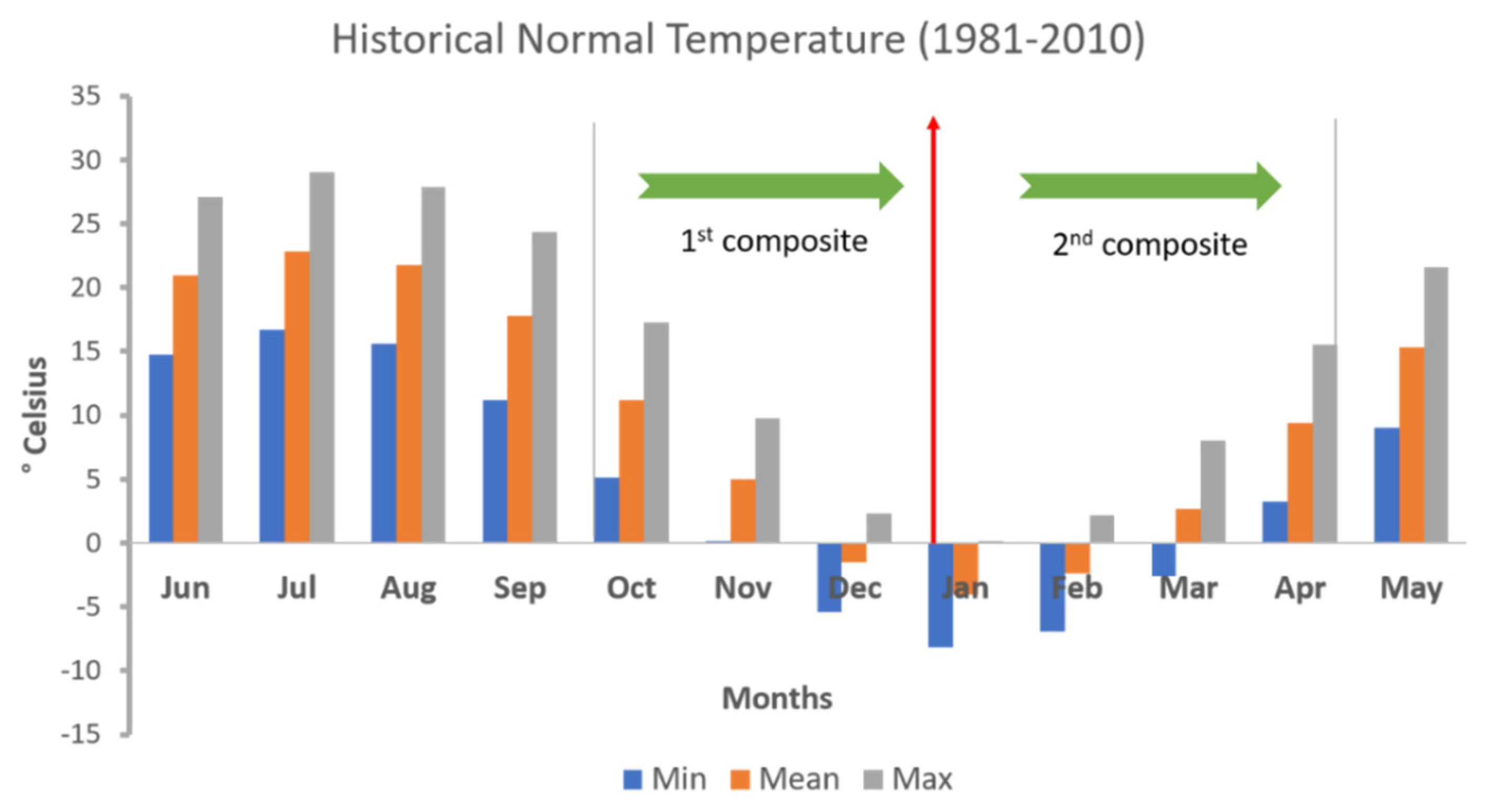
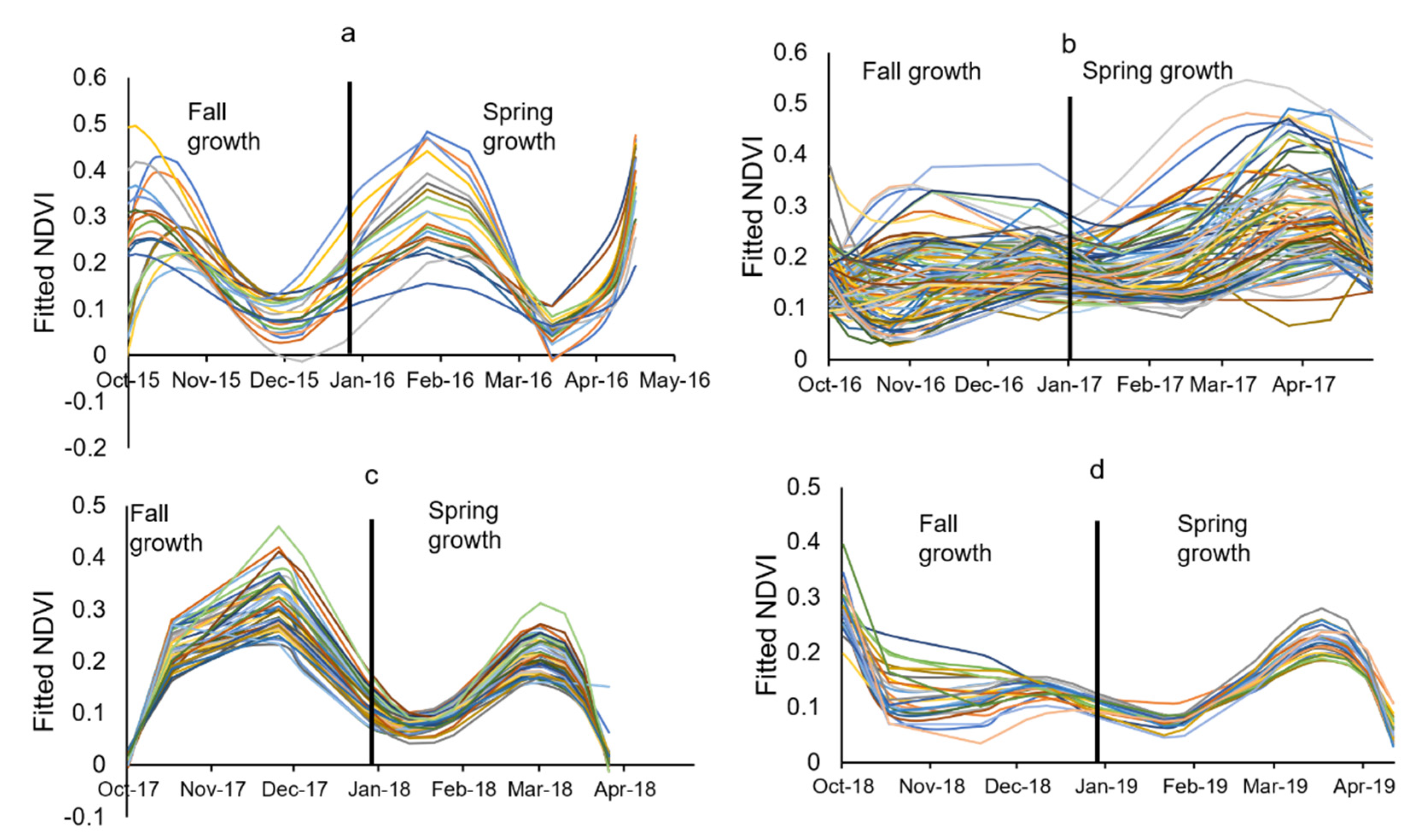
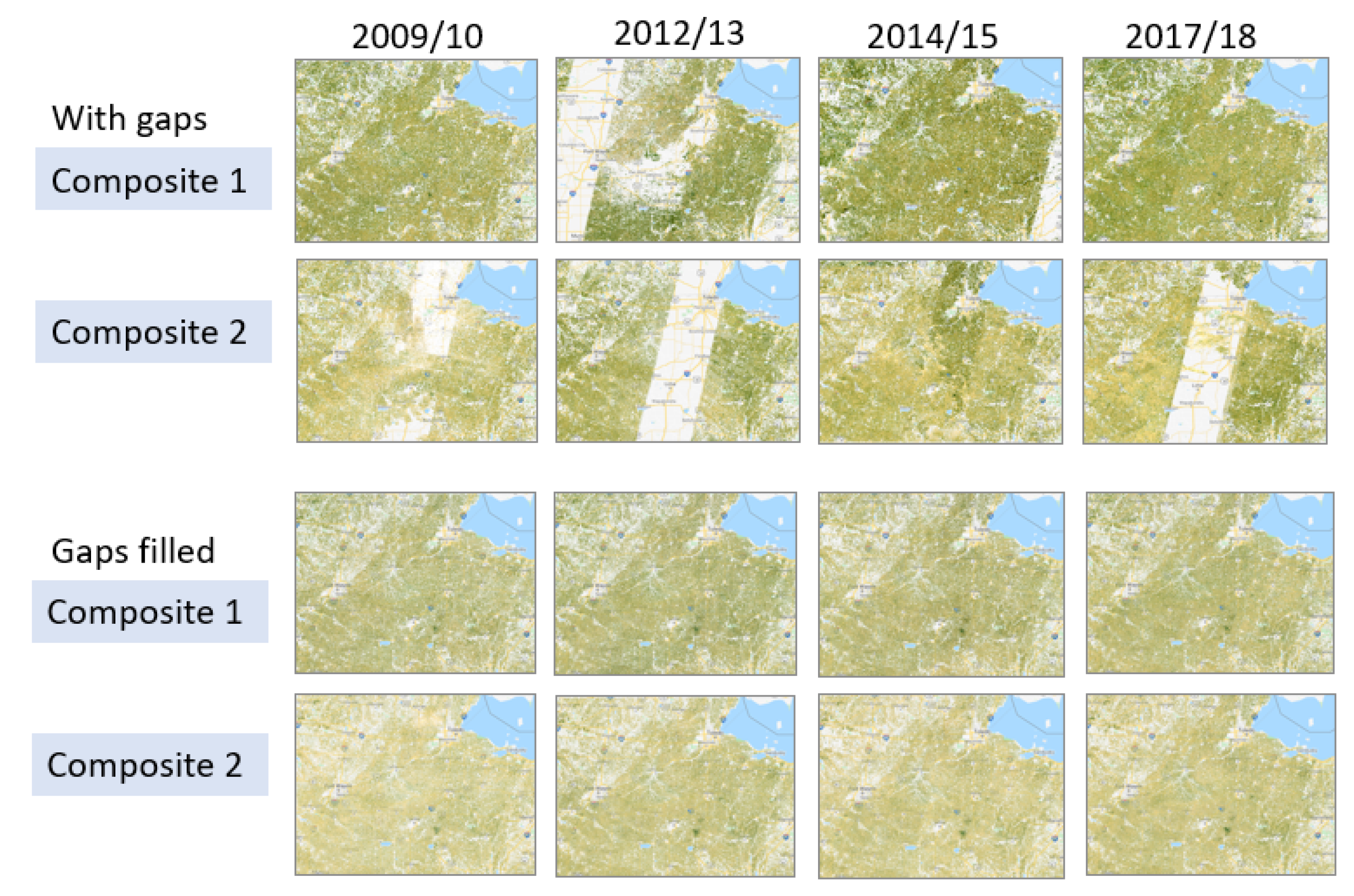
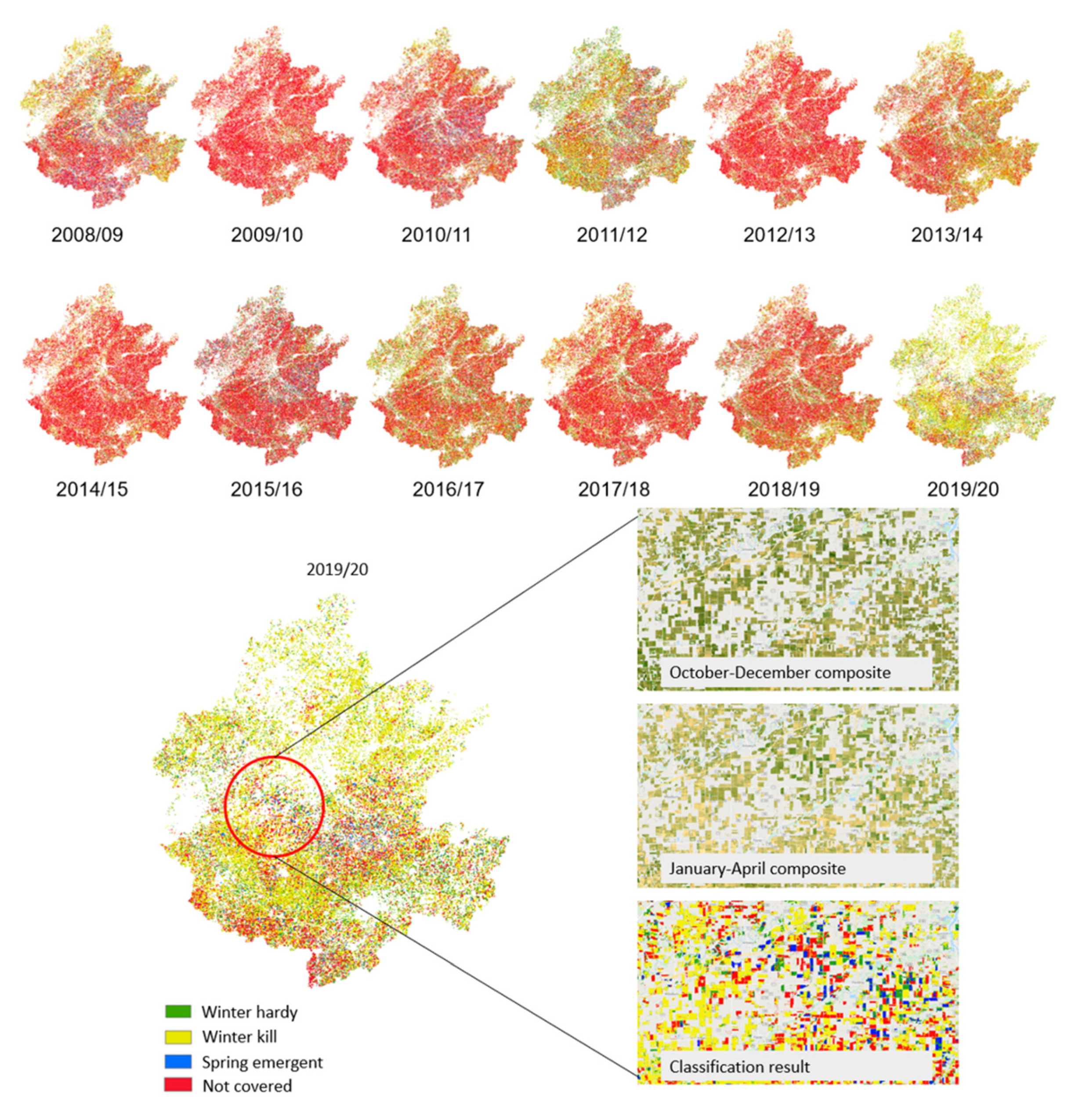
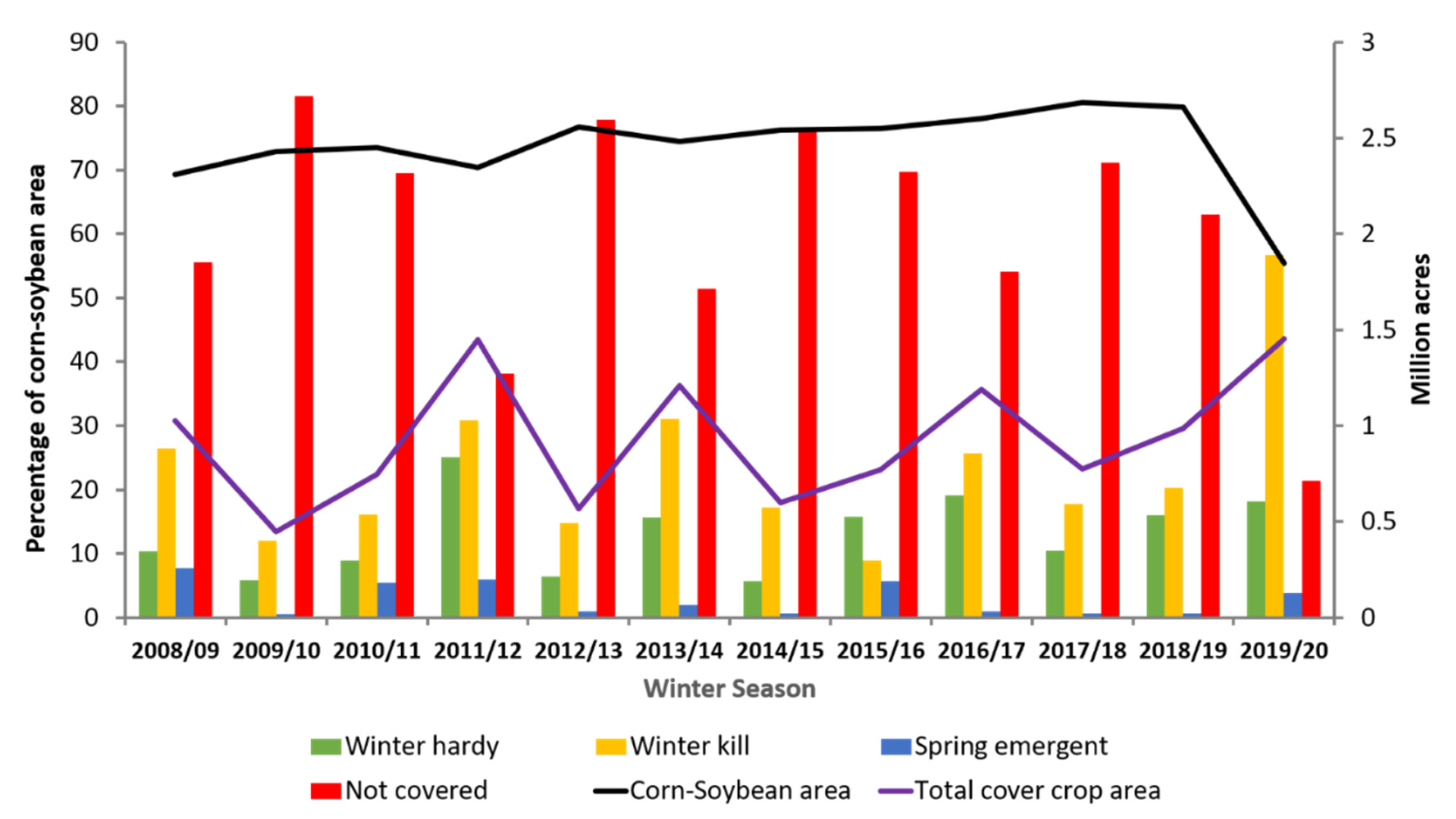
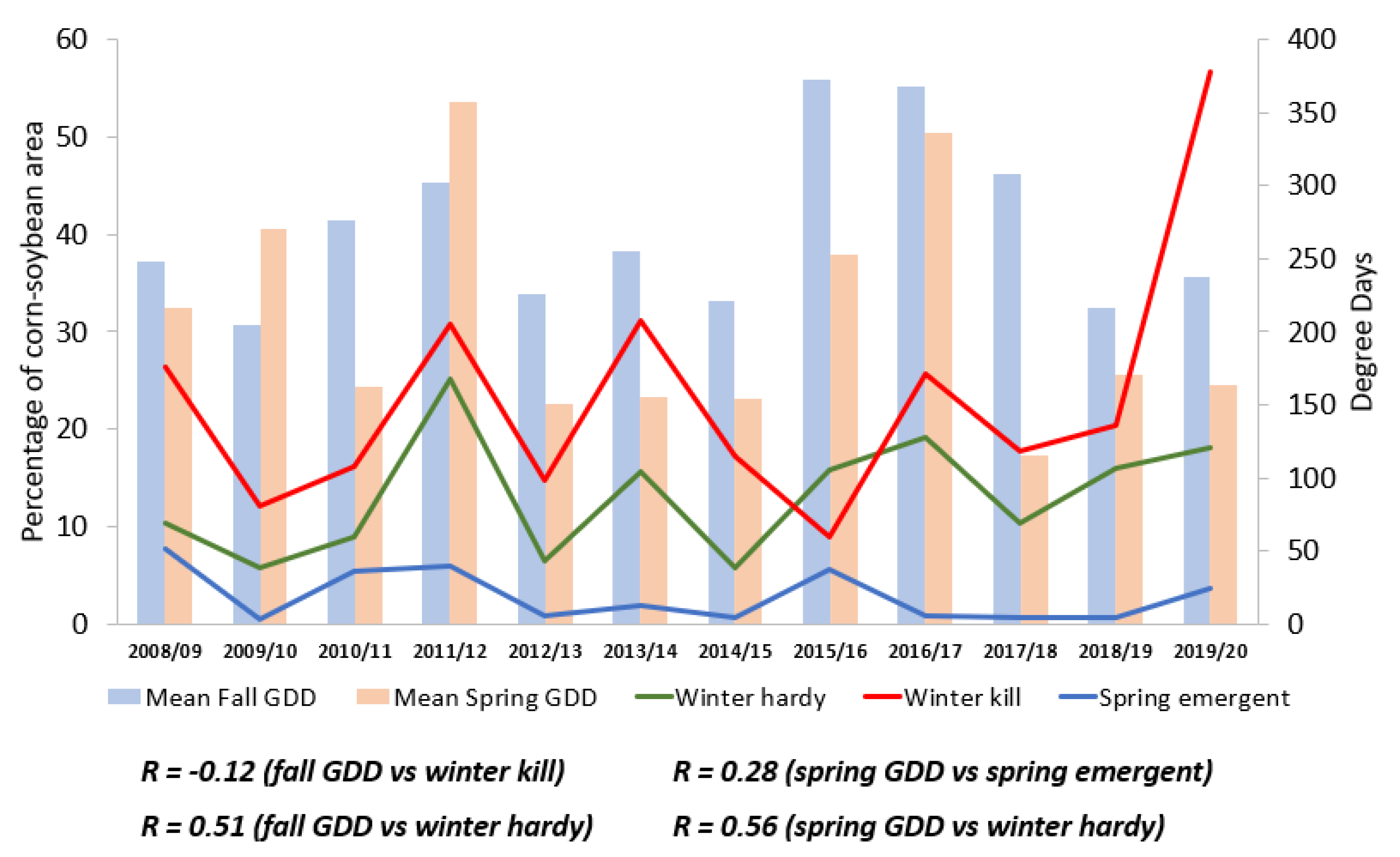
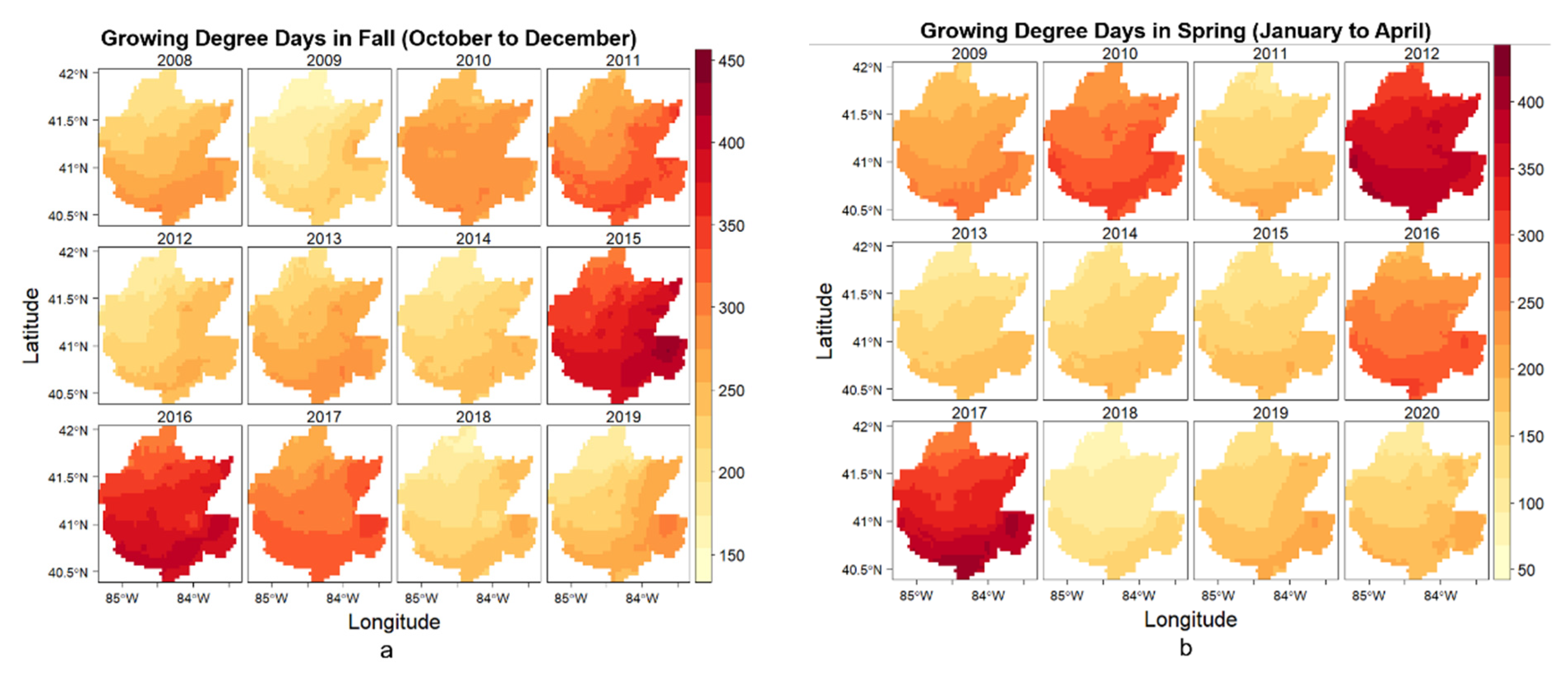
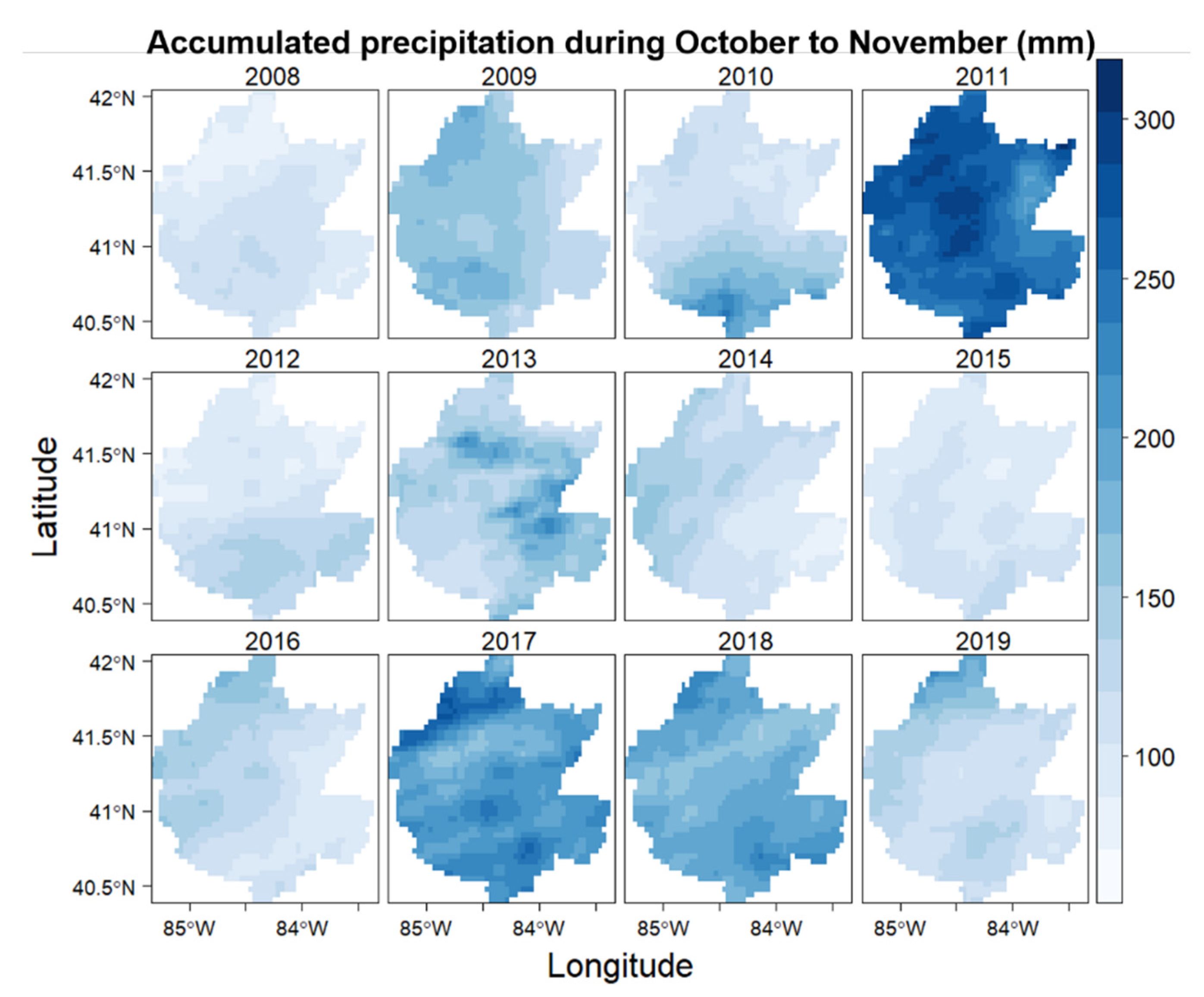
| Dataset | Data Products | Spatial/Temporal Resolution | Launch/Data Availability |
|---|---|---|---|
| Landsat 8 OLI | Level-2 SR [31] | 30 m (16 days) | 2013 (2013–Present) |
| Landsat 7 ETM+ | Level-2 SR [32] | 1999 (2000–Present) | |
| Landsat 5 TM | Level-2 SR [32] | 1984 (1984–2012) |
| Composite Band | Description | Composite Band | Description |
|---|---|---|---|
| Blue_median | Median of blue band | DVI_median | Median of DVI |
| Green_median | Median of Green band | NDVI_median | Median of NDVI |
| NIR_median | Median of NIR band | NDVI_max | Maximum of NDVI |
| Red_median | Median of Red band | NDVI_min | Minimum of NDVI |
| SWIR1_median | Median of SWIR1 band | NGRDI_median | Median of NGRDI |
| SWIR2_median | Median of SWIR2 band | RVI_median | Median of RVI |
| Criteria | Class | Number of Fields |
|---|---|---|
| Fall NDVI and Spring NDVI ≥ 0.3 | Winter-Hardy | 338 |
| Fall NDVI ≥ 0.3 and Spring NDVI < 0.3 | Winter Kill | 134 |
| Fall NDVI < 0.3 and Spring NDVI ≥ 0.3 | Spring Emergent | 24 |
| Fall NDVI and Spring NDVI < 0.3 | Not Covered | 132 |
| Predicted | |||||||
|---|---|---|---|---|---|---|---|
| Ground-Truth | Class | Winter Hardy | Winter Kill | Spring Emergent | Not Covered | Total | PA |
| Winter Hardy | 8168 | 895 | 813 | 958 | 10,834 | 75.39% | |
| Winter Kill | 1144 | 4300 | 7 | 987 | 6438 | 66.79% | |
| Spring Emergent | 279 | 37 | 843 | 309 | 1468 | 57.42% | |
| Not Covered | 302 | 1438 | 441 | 9203 | 11,384 | 80.84% | |
| Total | 9893 | 6670 | 2104 | 11,457 | 30,124 | ||
| UA | 82.56% | 64.47% | 40.07% | 80.33% | |||
| Overall Accuracy = 74.7% | Kappa = 0.63 | ||||||
Publisher’s Note: MDPI stays neutral with regard to jurisdictional claims in published maps and institutional affiliations. |
© 2021 by the authors. Licensee MDPI, Basel, Switzerland. This article is an open access article distributed under the terms and conditions of the Creative Commons Attribution (CC BY) license (https://creativecommons.org/licenses/by/4.0/).
Share and Cite
KC, K.; Zhao, K.; Romanko, M.; Khanal, S. Assessment of the Spatial and Temporal Patterns of Cover Crops Using Remote Sensing. Remote Sens. 2021, 13, 2689. https://doi.org/10.3390/rs13142689
KC K, Zhao K, Romanko M, Khanal S. Assessment of the Spatial and Temporal Patterns of Cover Crops Using Remote Sensing. Remote Sensing. 2021; 13(14):2689. https://doi.org/10.3390/rs13142689
Chicago/Turabian StyleKC, Kushal, Kaiguang Zhao, Matthew Romanko, and Sami Khanal. 2021. "Assessment of the Spatial and Temporal Patterns of Cover Crops Using Remote Sensing" Remote Sensing 13, no. 14: 2689. https://doi.org/10.3390/rs13142689
APA StyleKC, K., Zhao, K., Romanko, M., & Khanal, S. (2021). Assessment of the Spatial and Temporal Patterns of Cover Crops Using Remote Sensing. Remote Sensing, 13(14), 2689. https://doi.org/10.3390/rs13142689





